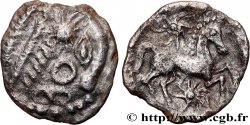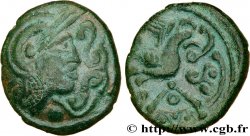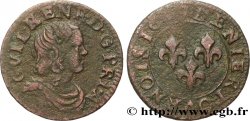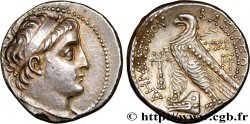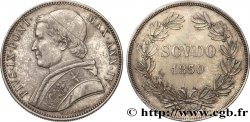Live auction - bga_705840 - GALLIA BELGICA - BELLOVACI (Area of Beauvais) Quart de statère d'argent à l'astre, tête à gauche, revers à l’éclipse
You must signin and be an approved bidder to bid, LOGIN TO BID. Accounts are subject to approval and the approval process takes place within 48 hours. Do not wait until the day a sale closes to register. Clicking on "BID" constitutes acceptance of the terms of use of cgb.fr private live auctions.
Bids must be placed in whole Euro amounts only. The sale will start closing at the time stated on the item description; any bids received at the site after the closing time will not be executed. Transmission times may vary and bids could be rejected if you wait until the last second. For further information check the Live auction FAQ
All winning bids are subject to a 18% buyer’s fee.
All winning bids are subject to a 18% buyer’s fee.
| Estimate : | 950 € |
| Price : | 670 € |
| Maximum bid : | 690 € |
| End of the sale : | 08 March 2022 15:47:22 |
| bidders : | 2 bidders |
Type : Quart de statère d'argent à l'astre, tête à gauche, revers à l’éclipse
Date: c. 80-50 AC.
Mint name / Town : Beauvais (60)
Metal : silver
Diameter : 14,5 mm
Orientation dies : 6 h.
Weight : 1,81 g.
Rarity : R3
Coments on the condition:
Flan un peu court et scyphate, mais avec les types de droit et de revers complets. Épaisse patine grise et brillante
Catalogue references :
Predigree :
Ce denier provient du catalogue Poinsignon 42, de juin 1997, n° 314. Il illustre le Nouvel Atlas, tome IV, n° S 282 A. C’est le n° 1595 de MONNAIES 41 (vendu 930€ sur un ordre maximum de 1210€ avec 4 ordres). Il provient de la collection Claude Lainé (emblème luni-solaire)
Obverse
Obverse legend : ANÉPIGRAPHE.
Obverse description : Restes de tête humaine à gauche avec un astre derrière l’oeil, un annelet sous l’oeil et une S en guise de bouche.
Reverse
Reverse legend : ANÉPIGRAPHE.
Reverse description : Cheval libre galopant à droite, surmonté d’un astre ; un croissant de lune posé sur un astre entre les jambes ; trois annelets derrière le cheval, confondus avec le grènetis.
Commentary
Avec un profil tourné à gauche, les auteurs du Nouvel Atlas considèrent ce denier comme une variété originale de la série 42B.
Pourtant, ce denier est issu du même coin de droit que les exemplaires n° 50 (JI12, D5-R7) et n° 57 (CG10, D5-R7) publiés par L.-P. Delestrée et C. Delplace dans leur article sur “La série trimétallique à l’astre témoin du monnayage bellovaque” dans les Mélanges offerts à J.-B. Colbert de Beaulieu.
Cet exemplaire rarissime avec la tête à gauche est donc issu du même coin de droit D5 que ces deux deniers provenant du site archéologique de Digeon. En ce qui concerne le revers, aucune monnaie publiée n’y correspond : ce denier a la particularité d’avoir un astre au-dessus du cheval et un autre entre les jambes, comme d’autres. Mais sa particularité est d’avoir un croissant de lune en superposition sur l’astre entre les jambes.
Cette représentation pourrait tout à fait être interprétée comme une éclipse, la Lune venant masquer la partie gauche du soleil ! Les trois annelets derrière le cheval et le superbe astre au-dessus du cheval pourraient, très logiquement, avoir eux aussi une interprétation astronomique... Il n’est plus à prouver que les Gaulois étaient de rigoureux observateurs des cieux étoilés.
With a profile turned to the left, the authors of the New Atlas consider this denier as an original variety of the 42B series.
However, this coin comes from the same right die as examples no. 50 (JI12, D5-R7) and no. 57 (CG10, D5-R7) published by L. -P. Delestrée and C. Delplace in their article on “The trimetallic series with the star witnessing the Bellovaque coinage” in the Mélanges offered to J. -B. Colbert de Beaulieu.
This extremely rare example with the head on the left therefore comes from the same D5 obverse die as these two deniers from the archaeological site of Digeon. As for the reverse, no published coin corresponds to it: this denarius has the particularity of having a star above the horse and another between the legs, like others. But its particularity is to have a crescent moon superimposed on the star between the legs.
This representation could quite easily be interpreted as an eclipse, with the Moon covering the left side of the Sun! The three rings behind the horse and the superb star above the horse could, very logically, also have an astronomical interpretation.. . . It is no longer necessary to prove that the Gauls were rigorous observers of the starry skies.
Pourtant, ce denier est issu du même coin de droit que les exemplaires n° 50 (JI12, D5-R7) et n° 57 (CG10, D5-R7) publiés par L.-P. Delestrée et C. Delplace dans leur article sur “La série trimétallique à l’astre témoin du monnayage bellovaque” dans les Mélanges offerts à J.-B. Colbert de Beaulieu.
Cet exemplaire rarissime avec la tête à gauche est donc issu du même coin de droit D5 que ces deux deniers provenant du site archéologique de Digeon. En ce qui concerne le revers, aucune monnaie publiée n’y correspond : ce denier a la particularité d’avoir un astre au-dessus du cheval et un autre entre les jambes, comme d’autres. Mais sa particularité est d’avoir un croissant de lune en superposition sur l’astre entre les jambes.
Cette représentation pourrait tout à fait être interprétée comme une éclipse, la Lune venant masquer la partie gauche du soleil ! Les trois annelets derrière le cheval et le superbe astre au-dessus du cheval pourraient, très logiquement, avoir eux aussi une interprétation astronomique... Il n’est plus à prouver que les Gaulois étaient de rigoureux observateurs des cieux étoilés.
With a profile turned to the left, the authors of the New Atlas consider this denier as an original variety of the 42B series.
However, this coin comes from the same right die as examples no. 50 (JI12, D5-R7) and no. 57 (CG10, D5-R7) published by L. -P. Delestrée and C. Delplace in their article on “The trimetallic series with the star witnessing the Bellovaque coinage” in the Mélanges offered to J. -B. Colbert de Beaulieu.
This extremely rare example with the head on the left therefore comes from the same D5 obverse die as these two deniers from the archaeological site of Digeon. As for the reverse, no published coin corresponds to it: this denarius has the particularity of having a star above the horse and another between the legs, like others. But its particularity is to have a crescent moon superimposed on the star between the legs.
This representation could quite easily be interpreted as an eclipse, with the Moon covering the left side of the Sun! The three rings behind the horse and the superb star above the horse could, very logically, also have an astronomical interpretation.. . . It is no longer necessary to prove that the Gauls were rigorous observers of the starry skies.







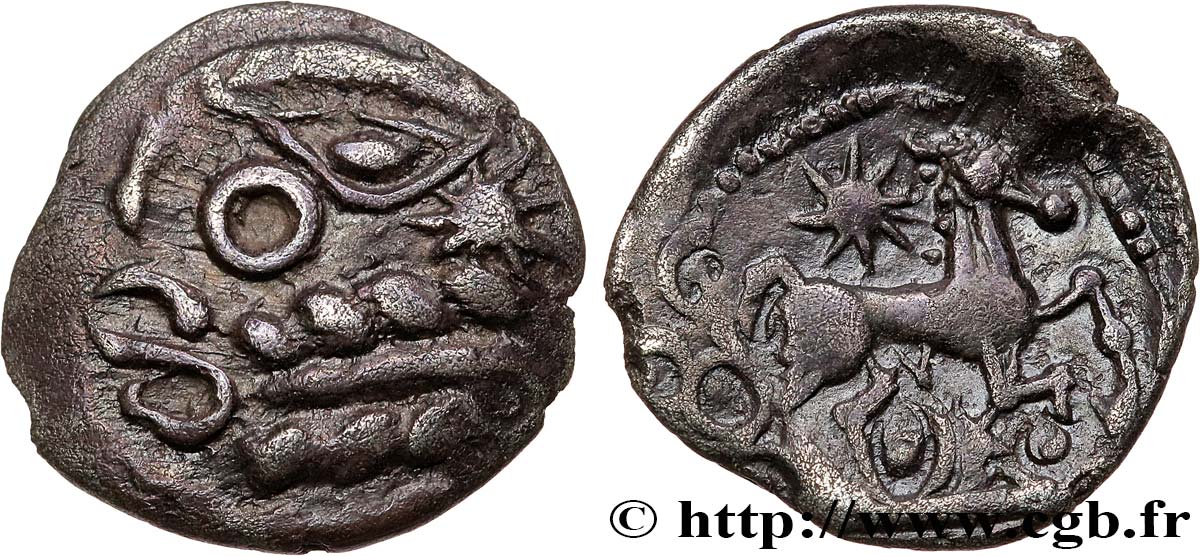
 Report a mistake
Report a mistake Print the page
Print the page Share my selection
Share my selection Ask a question
Ask a question Consign / sell
Consign / sell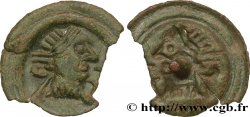
 Full data
Full data


